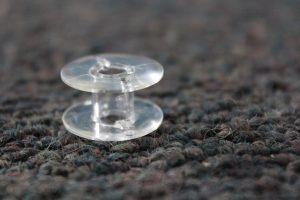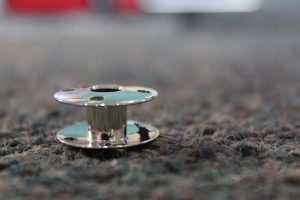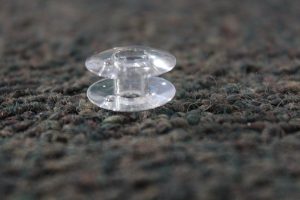Today I would like to cover a topic that can be very confusing – sewing machine bobbins and bobbin cases. It is very common in our shop to see misplaced and incorrect bobbins. I couldn’t possibly cover every type of bobbin in this post, but by the end of this primer, you’ll understand what your bobbin/bobbin case is and how to get replacement ones.
This primer will be in two parts – since it is a lot to cover. This is part one, which will be covering bobbins. Part two will be covering bobbin cases.
Bobbins – What Are They?
Before we delve into the types of bobbins, allow me to explain what the bobbin is, and its function.
The bobbin is a small “spool” of thread that you wind yourself (or buy pre-wound) and put in the bottom of the machine. This thread will become the stitches on the underside of your fabric when you sew. This thread actually interlocks with the thread that goes through the needle. How this actually works will be covered in another post, as it is somewhat confusing and requires thorough explanation.
Fun Fact! The term “bobbin” actually comes from the French word “bobine”, which translates roughly to “coil”.
Bobbin Styles

There are a lot of bobbin styles. I would need an entire book to cover all of them, so I will cover the most common ones here. The four most common bobbins will work in most machines. European machines (Pfaff, Bernina, Elna, etc.) have a number of specialized bobbins that will not be covered by these.
Class 15 Bobbins


All Class 15 bobbins have flat flanges. You can buy these in plastic or metal. While they are technically interchangeable in most cases, it is recommended that you only use one or the other. The weight of the bobbin can affect your tension and the way the thread feeds. These are the most common bobbins, as they are used with removable and inset bobbin cases.
Class 66 Bobbins


All Class 66 bobbins have a slightly dome-shaped flanges. Just like Class 15 bobbins, they can be purchased in plastic or metal. Most modern machines of this class will have a plastic one. Again, they can be interchanged, but it is not recommended. These bobbins are used with inset bobbin cases with very few exceptions.
Other Styles

If you have an European machine, you should not be surprised if the four aforementioned bobbin styles do not fit your machine. Machines such as Pfaff, Viking and Bernina usually have specialized bobbins. These can be plastic or metal. Many of the plastic styles will be tinted with a color such as blue or green.
Choosing the Correct Bobbin
There are a few ways to make sure your replacement bobbins match.
- Check the “parts” section of your user manual
- Bring the bobbin or bobbin case (if removable) your machine came with (provided it was purchased new)
- Bring the name of the machine manufacturer (Singer, Kenmore, etc.) and the model number
- Bring the entire machine
We keep most bobbin styles in stock, and can order especially uncommon ones.
Other Notes on Bobbins
Many modern machines have a function that will alert you when the bobbin is running low. If you have a machine that does this, you probably need a plastic bobbin. The photoeye that tells the machine when the bobbin is low needs to see the thread – a metal bobbin will block this.
If you have a machine that was manufactured pre-1960’s, it will most likely take a metal bobbin.
If you have a Singer sewing machine that winds the bobbin in the bobbin case, there are three different bobbins that it may be. They are extremely specialized and will not fit in any other model.
Very old machines can have what is called a long-shuttle bobbin. We carry these, too!
There are many styles of bobbins, but luckily you only need to know what bobbins your machines take! Truly, the easiest way to find new bobbins is to locate the model number to your machine. This is typically found on a little sticker on the back, right side, or bottom of your machine. Many machines also have the model written on the front, like a Pfaff “7570” or a Singer “706”. These can be a mix of letters and numbers, or just numbers. Once you find this model number, write it down! It will come in handy for locating parts and information for your machine.
If you have a hard time locating your machine’s model number, bring in the machine or a bobbin case if it is removable.
In the next post, I’ll be covering bobbin cases, so stay tuned! Click here for Part Two!
Sarah
Virgilee says
Question… I have a Sears Kenmore machine model #385.19153. Will a singer Class 66 bobbin work in it, or do I need a class 15?
Sarah says
Virgilee,
Your machine takes a 15 class bobbin.
Thanks for the question!
Tanya says
I have a Pfaff Ambition 1.0. Can I only use Pfaff bobbins?
Sarah says
Tanya,
Yes, you should only be using Pfaff brand bobbins with your machine. Although other sizes may appear to fit, you run the risk of damaging your machine with them.
Thanks for the question!
Margarita says
Hi I have a 1911 Pfaff shuttle bobbin treadle machine and only one bobbin. Do you have any bobbins for this model?
Sarah says
Hi Margarita, I’d recommend bringing in the bobbin case and/or the bobbin so we can take a look – unfortunately, there’s no way for us to look up parts for a machine of that age!
Sumaiya says
Hi i have a pfaff 1221 what bobbin fits in there
Sarah says
Hi Sumaiya,
Pfaff 1221 takes a Pfaff-specific bobbin. You’ll need metal Pfaff bobbins, which you should be able to find at any store that carries Pfaff products.
Fred Gowland says
Hi Sarah
What a great primer and so nice to have the pictures! My question is related to a PFAFF 6 (made in 1954 in Germany). My repair store told me I was using the wrong bobbin because the bobbin winding mechanism wasn’t working properly for the one I was using. After looking at your pictures I have been using a bobbin with a number of wholes in the topped bottom. I also have some bobbins that are “solid” (non perforated) and they also look like class 15 bobbins. I can’t find a parts manual for this machine and the user manual is silent on bobbin type.
Sarah says
Hi Fred, it appears that your Pfaff 6 does use Class 15 bobbins. Pfaff can be tricky sometimes because they have machines that use both Class 15 bobbins as well as machines that use their specific kind. Older machines usually have the Class 15 bobbins, but if those bobbins are “taller” than your bobbin case, you may need to source some of Pfaff’s exclusive bobbins. If you’re having trouble finding them, you may have some luck with contacting Pfaff directly, or speaking to a local Pfaff dealer. Hope this helps!
Retha Greiner says
Does my Pfaff machine need Pfaff bobbin case?
Sarah says
Hi Retha! Yes, Pfaff machines need bobbin cases specific to their models. You want to make sure you’re using Pfaff-approved/genuine parts in your machine.
Joy says
Are 7 hole and 10 hole metal bobbins interchangeable?
Sarah says
Hi Joy – usually the number of holes has very little to do with the class of the bobbin. If you have both, compare the diameter and height. If they’re the same, you have two styles of the same class bobbin (most likely due to different manufacturers). Hope this helps!
Tamara Haxton says
Is there a difference between a Class I5 bobbin a d a Class I5 J bobbin. Its for my Singer Patchwork 7285Q machine. My manual says Class I5 J and I accidentally bought just Class I5.
Sarah says
Hi Tamara, regular 15 class bobbins work with your machine – the J just means the bobbins were manufactured in Japan!
Karen Schmieding says
I have an elna 7000 for years just order a brother sq9285 can I use the same bobbin if not what bobbin do I need to order thx karen
Nohora says
Hi Sarah, thank you very much for the information. I have a Katherine Baby Lock sewing machine, I went to the store and bought some bobbins class 66; are those the correct ones for my machine?
Sarah says
Hi Nohora, it looks like that machine actually takes a 15 class bobbin.
Sarah says
Hi Karen, thanks for your question! It looks like your Elna machine took a specialty bobbin – it most likely will not work in your Brother machine. The Brother machine takes a 15 class plastic bobbin.
Donna says
I have a machine that takes an M bobbin. M bobbins can be solid, or have holes all around the top and bottom. Is there a function to this, or a difference??
Sarah says
This is a manufacturer difference – as well as a sewing preference. The holes make it easier to see how much thread is left on the bobbin, and can be used to thread the bobbin. Both will work!
Geneva says
I have a Singer 9410. I dont know what size bobbin I need and if I need a bobbin case bc I brought it from the flea market.
Diana says
I had an older Kenmore sewing machine. My new Singer, Sewmate 5400, takes a class 15 bobbin. Can I use my bobbins from the Kenmore In my Singer?
Sarah says
Hi Diana! Most Kenmore machines do take a 15 class bobbin, but not all. A model number would be helpful in determining that.
Sarah says
Hi Geneva, that machine takes a 66 class bobbin. Unfortunately, I can’t tell you if it needs a new bobbin case or not! If it’s missing or broken, you definitely need it replaced. If you’re having a problem sewing on the machine, it could be any number of problems.
Xenia says
Sarah, I have the following machines:
Brother XL2130
Singer Melodie 60 (5808)
I keep struggling to remember which one takes which bobbin?
Sarah says
Hi Xenia,
The Brother machine takes a 15 class bobbin (the taller style) and the Singer machine takes a 66 class (the shorter, rounded style). Hope that helps!